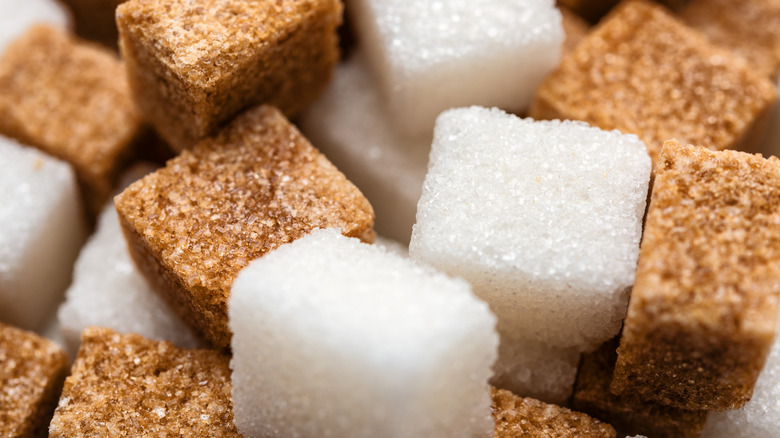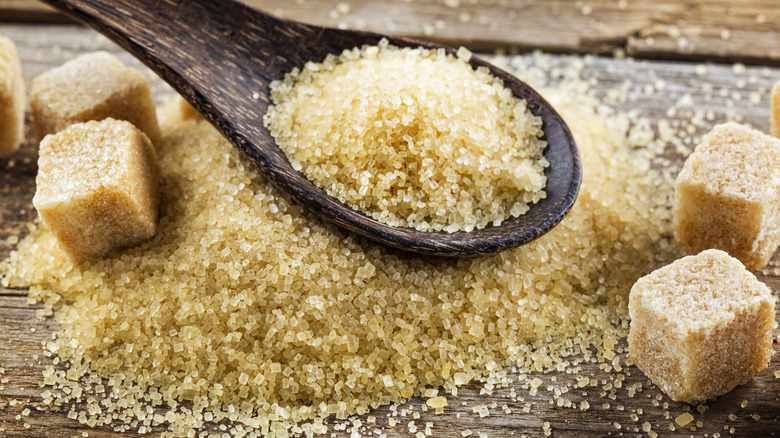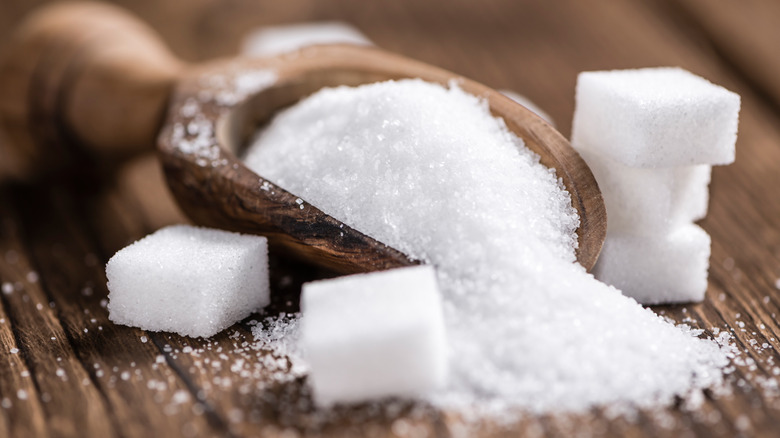Brown Sugar Vs White Sugar: Differences & How To Substitute One For The Other
Whether you're making cookies or your morning coffee, sugar is a vital ingredient in many dishes, savory and sweet. There are many different types of sugar, but the two most common are white and brown. While both are delicious, it can be frustrating to rearrange your kitchen in search of one kind only to find the other. Luckily, in some circumstances, they are completely interchangeable, but other times not. Even though both brown and white sugar can bring sweetness to a recipe, the two are still different ingredients with their own flavors and uses.
White and brown sugar comes from either sugarcane or sugar beets. The two are harvested and pressed to get the same basic raw result — a sweet, watery liquid, that — after being processed and exposed to heat — turns into syrupy molasses. Then, sugar crystals are extracted from the molasses by putting it in a centrifuge. The sugar crystals are then filtered and purified until all that's left is pure white sugar, and at this point, the crystals may be infused with molasses to create refined brown sugar. Alternatively, the refining process may be shortened to make unrefined brown sugar that naturally contains molasses.
Flavor and texture differences between the sugar
There are different iterations of each kind of sugar, such as light brown, dark brown, or turbinado brown sugar, and granulated or powdered white sugar. Each type of sugar is best suited for different things, but there are some general distinctions that can be made between white and brown sugar. Due to the presence of molasses, brown sugar has a thicker, more moist texture than white sugar. It also has a richer taste with notes of caramel. Because of its flavor and density, brown sugar is generally better suited for heavier baked goods like cakes and cookies, though it's also used to enhance things like barbecue sauce.
White sugar, on the other hand, is lighter in texture, flavor, and coloring. White sugar has a more dry, sandy feel, and unlike brown sugar, won't affect the color of the final dish. This is why white sugar is preferred when making airy desserts like meringues or angel food cake. Instead of having a complex flavor profile like brown sugar, white sugar tastes of pure sweetness. White sugar is used more as a neutral ingredient to fulfill the purpose of sweetening a recipe, while brown sugar brings more of a noticeable flavor to dishes.
How to substitute one sugar for the other
Brown and white sugar can be swapped out for each other depending on the recipe, but you will most likely notice the difference. For example, if you were to make a batch of cookies, you could use the same amount of brown or white sugar and create a delicious final product. But if you use brown sugar, the cookies will probably be darker and chewier than if you were to use white sugar. It's difficult to replicate the delicateness of white sugar with brown sugar. If you are substituting brown for white, you can try to offset the excess moisture by adding more dry ingredients to your recipe, but it will take a lot of trial and error. Achieving the taste of brown sugar with white sugar is much simpler — just add some molasses. If a recipe calls for a cup of brown sugar, use a cup of white sugar and a tablespoon of molasses (maple syrup also works in a pinch).
There are some instances when dense brown sugar simply can't be used in place of white sugar. If you're making something especially light like a sugary glaze or a soufflé, white sugar should be used so the dish isn't weighed down. But in many other cases, white and brown sugar can be substituted for each other with a one-to-one ratio.


